
Invasive Species in the Great Lakes: What’s the Big Deal?
Presented By: Dr. Thomas Lauer, Director of Aquatics, Ball State University
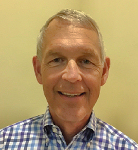
Dr. Thomas
Lauer
Dr. Lauer started the talk by defining native and non-native species. Native species like lake trout are
those found in an area in the Great Lakes. While non-native, or non-indigenous, exotic species are
those living beyond their native range. Invasive species are those that threaten the diversity or
abundance of native species, or threatening ecologic stability.
There are about 43,000 invasive species in the United States. One notable invasive species is the
Emerald Ash Borer that destroy ash trees. Others are Kudzu, Burmese Pythons, etc. As invasive
species grow, they influence the population and increase mortality of the native species. They will eat
organisms that native species require for their survival.
Zebra Mussels are one of the most significant invasive species of the Great Lakes. They originated
from the Caspian Sea, migrated to Europe and then to the United States. They are filter feeders and
fed on plankton which are food for other organisms. They arrived in the United States probably
around 1989 via “ballast water” of oceans ships. Having few predators, their population exploded.
They plugged water intake pipes, grow on native mussels and take their food supply away causing
near 100% mortality to native mussels.
The Sea Lamprey is the second example of invasive species in the Great Lakes. They are parasites
that attach themselves to the native fish and fed off the fish until the fish die. They came through the
canal system from the East Coast. Their infestation caused the lake trout population to drop 98%.
One solution to the problem is by killing the juvenile parasites with the chemical TFM.

Emerald Ash Borer
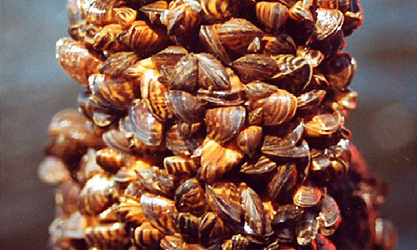
Zebra Mussels
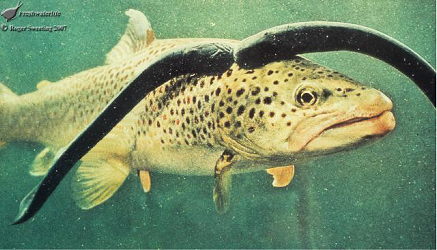
Sea Lampreys
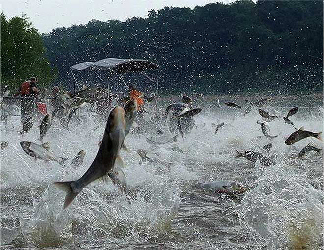
Asian Carp
In summary: Introduction of new organisms is continuous and on going. Invasive species are destructive to the environment. They are expensive to manage. We are all affected.
Notes by Gonz Chua
Genetic Genealogy Ancient Migrations and the Citizen Scientist
Presented By: Steve Frank, Attorney
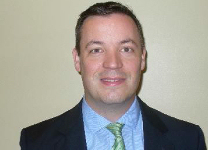
Steve Frank
Mr. Frank is a deputy attorney general at the office of the Indiana Attorney General. He is a graduate
of the McKinney Law School of Indiana University.
John Craig Venter is an American scientist who is known for being one of the first to sequence the
human genome. In the last 10 years the cost of sequencing a genome has fallen dramatically from
millions to $1000 or less. Commercial companies such as 23 and Me, Family Tree DNA and Ancestry
DNA provide a limited sequencing for well under $500.
There are several important points for understanding DNA basics. There are 23 pairs of
chromosomes. One through 22 chromosomes contain autosomal DNA. Chromosomes 23 are the sex
chromosomes with double X being female and XY being male. There is also mitochondrial DNA.
Autosomal DNA is a term used in genetic genealogy to describe DNA which is inherited from the 22
pairs of autosomal chromosomes - inherited from both parents including contributions from the
parents, grandparents, and so on. Humans have 22 pairs of autosomes. The sex chromosomes are
involved in the determination of the sex of humans and other organisms. Mitochondrial DNA is
passed from only the mother to her offspring.
Using these DNA patterns, one can study the migration of mankind out of Africa to the rest of the
inhabited world. The African migration started about 120,000 to 150,000 years ago. The most recent
migration is of the Eskimos and the Aleutians, 8000 to 10,000 years ago. More recently, genetic
sequences, along with the anthropological material, were used to identify the remains of England's
King Richard III. Similarly, the purported offspring of Thomas Jefferson and Sally Hemming had their
paternity established.
Autosomal DNA is the cheapest, most used, and most versatile DNA test. It is helpful in providing
ethnic origins, ancient and more recent information, matches to establish living cousins and health
information. Information from these sources was used to show that modern humans interbred with
Neanderthals shortly after leaving Africa. All modern humans other than Africans have Neanderthal
DNA in the range of 2-4% of their genome.
DNA from adoptees has been very helpful in establishing the birth parents.
The commercial services such as Ancestry.com have been acquiring a great deal of genetic
information on humans. Some interchange of this material happens between the similar
organizations. There is concern on the part of some with privacy issues and because the field is so
new there is very little legislation in this regard.
Additional resources to explore include: 1. Gedmatch.org which provides additional tools for
genealogicaly DNA analysis; 2. DNA.Land which is DNA study by Columbia University; 3.
Promethease.com which provides health reports based on DNA analysis; 4. DNA Adoption.com
which is a how-to guide for adoptees and everyone else.
For those with more interest there is a Central Indiana DNA Group which meets at the Fishers Public
Library. The next meeting will be on August 2, 7-8pm, on an Intrduction to GEDMatch.
Notes by Jerry Kurlander
The Spectacle of August 21, 2017 - America’s Great Solar Eclipse
Presented By: John Wharton, Managing Director of Facility Operations, St Louis Science Center

Steve Frank
John Wharton is a fellow of the International Planetarium Society and the Great Lakes Planetarium
Association. He gave a very interesting presentation of the solar eclipse that will occur on August 21,
2017.
The last total eclipse in the continental U.S. was in 1979. The last total eclipse to go across the U.S.
was in 1918 and the last total eclipse in Indianapolis was in 1205. A total eclipse doesn’t happen very
often. The path of the 2017 total eclipse will run across the U.S., through 12 states, from Oregon to
South Carolina. Ten million people live within the path of totality and another 50 million are within an
hour’s drive.
Many communities within the path of totality, such as Hopkinsville, KY, are already having people
from Europe book rooms in hotels. There will be an economic boom to such communities. It’s good
for the soul, as to witness a total eclipse of the sun is a privilege that comes to but a few people.
Once seen, it is a phenomenon never to be forgotten.
A solar eclipse occurs when the moon moves exactly between the sun and the part of the earth on
which the total eclipse occurs. The area of totality is much smaller than the area of the partial eclipse.
He presented an interesting series of photographs from space showing the dark area of an eclipse
moving across the earth. At the midpoint of the eclipse, in the center of the eclipse path, the totality
will only last about 2 minutes and 42 seconds. The shadows get more sharp as an eclipse
progresses. Waves or ripples may appear on white surfaces.
If you look at the sun for even a short time without proper protection, you may damage the retina of
your eye. Safety is very important in viewing an eclipse. To safely view an eclipse, you can do any of
the following:
1. Use a pinhole to project the sun onto a flat surface, such as a sheet of cardboard.
2. Use solar viewing glasses designed for viewing the sun. Check them beforehand to be certain
there are no cracks or pin holes. Or use number 14 welder’s glass.
Suggested sites for observing an eclipse are Nashville, TN or St Louis MO. One uncertainty is the
possibility of clouds, which is usually about 60% on that day in the Midwest. If you miss the 2016
eclipse, there will be a total eclipse on April 8, 2024 in Indy, with the eclipse path centered on
Bloomington, IN.
For More Information:
http://stlouiseclipse2017.org
http://eclipse2017.org
http://xjubier.free.fr/en/site_pages/solar_eclipses/TSE_2017_GoogleMapFull.html
Notes by Malcolm Mallette
Disease Prevention Using Low-Cost Diagnostic Tools
Presented By: Dr. Frédérique T. Deiss, Assistant Professor, Dept. of Chemistry/Chemical Biology, IUPUI
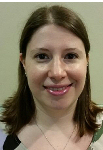
Dr. Deiss
Today’s talk was presented by Frédérique T. Deiss, Ph.D., Assistant Professor, Department of
Chemistry and Chemical Biology in the School of Science of IUPUI. Her previous appointments
include the University of Alberta and Harvard University. She received her Ingenieur ENSCPB,
Bordeaux and her Ph.D. from the University of Bordeaux in 2009.
She spoke about new applications of paper as low-cost diagnostic tools. Her philosophy in her
research was stated by J.T Kurek in “Think like a Molecule.” She believes that the present level of
knowledge is vast, but we need reassembly (thinking out-of- the-box) to use this knowledge in making
something new. All of her current research is based upon the use of paper as something that is being
used less and less. Patterning of paper has already been used in paper diagnostic tools starting with
the paper strip assays for glucose in urine, lateral flow pregnancy tests and organic synthesis on
paper. She started her research using a standard printer and doing wax printing to generate micro
fluid channels on paper. This is done by simply baking the paper at 120°C in an oven after it has
been printed. Point-of-care diagnostic testing is the best test for those in the world who really need it.
Such a test can be affordable, sensitive, specific, user friendly, rapid, equipment free and produced
by those in need of the test.
In 2014 she developed a portable paper-based culture device for antibiotic susceptibility
assays. In her research she had 11th and 12th grade students making these simple test devices using
nothing more than a printer and packing tape. These devices are similar to the growth rates seen in
agar, LB media and portable devices. In 2014 as a post doctoral fellow at the University of Alberta,
Canada, Dr. Deiss received the Sentinel EXCELerator award for the detection of bacteria in food and
water in low-resource settings, with low-cost portable electrochemical paper-based devices.
Her paper-based devices can also be used for the detection of traces of inorganic explosive
materials such as chlorate, and bromate.
Electrochemistry bacterial detection can also be done on paper. There are three types of
paper based devices presently being made: no tail devices, tape tail devices and paper tail devices
This research provides some interesting challenges like electrode attachment and leakage between
the cells. These challenges again were solved by the use of a simple material, Teflon, and again
packing tape.
There was no easy way to modify paper to restrict chemicals such as organic solvents, bases
and acids or surfactants in particular areas. The discovery of using Teflon, they have dramatically
expanded the range of usable reagents and sped up the effort to develop multiple tests on a single
sheet. You can see the results of Dr. Deiss’ work in a for-profit company, Sentinel Bioactive Paper
Network, at www.syntarray.com .
Paper-based bioanalytical platforms exist in peptide binding, cancer cells and staining, drug
testing, cancer cell viability (fluorescence), AST of bacteria, colorimetric cells viability, analytes in
blood, and enzyme/amperometry/voltammetry.
It was a pleasure to see such a very intelligent young lady who, just one year ago, joined
IUPUI. IUPUI did an outstanding job of recruiting this level of talent to our city.
Notes by Hank Wolfla
WW II Memories of Jans Muller, MD
Presented By: Gonz Chua, Scientech Member
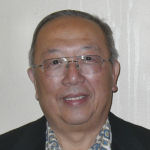
Dr. Gonz
Chua
The experience of Jans Muller MD in Indonesia under Japan’s WW II invasion
Gonz Chula, MD, a Scientech Club member, presented a talk originally given by Jans Muller, MD in
1996 at a WW II Roundtable. Jans and Gonz both lived under Japan’s occupation during WW II,
Muller in Java and Gonz in the Philippines.
Dr. Muller was born a Dutchman and passed away as a naturalized citizen of the USA. His father
was a physician who was doing missionary service in Indonesia. Jans and his mother were there with
his father when WW II started. The Dutch lost the war in May 1940 when the Netherlands was
overrun by Germany. In September 1940 Japan invaded the southern part of Indo-China, then a
French colony. Soon after the US cut off all oil shipments to Japan. Japan had no oil and was
dependent on oil from the US. There was a lot of oil in Indonesia, so Japan invaded Indonesia. The
US could not help Indonesia, as much of the fleet was destroyed at Pearl Harbor and many planes
were lost in the Philippines.

Indonesia
In March, 1942, Japan landed on the island of Java. Jans lived in the city of Yogyakarta (Jakarta) and
was an 11-year-old boy. He witnessed the surrender of the Javanese army to the Japanese military.
The Japanese tortured and killed officials who could not tell them about troops and supplies that did
not exist.
For a while there were mostly Japanese propaganda posters. He was disappointed as some of the
Javanese population wanted the Japanese to deliver them from the Dutch.
At first he was in a camp with his mother and father and things were not too bad for him. However,
young children with their mothers in the camp mostly died from lack of milk and formula,
gastroenteritis and other causes. At age12 he was separated from his family, deemed a dangerous
man.
He was moved to a different camp where he grew vegetables using human excrement for fertilizer.
The food for the people in the camp was gradually decreased. By 1945 the daily diet was 600
calories. He stopped growing and gaining weight. They ate anything, cats, dogs, snakes, birds and
roasted termites. In his camp there were old men (over 55), Catholic Nuns and boys 12 to 16 years
old.
There were 1200 old men at the start of the war in the camp and only 350 survived.
The old men got less food than the boys. His mother and father barely survived the war and would
not have survived had the atomic bombs not ended the war.
The latrines emptied into a creek that ran through the camp. Starving prisoners would look for grains
of corn (and other undigested ‘food’) in the creek that prisoners with diarrhea could not digest, take
the grains out of the filth, wash them and eat them. They were that desperate.
He was moved from that camp to one where he cut mahogany for firewood. There he developed
pellagra and had severe dysentery when on August 24, 1945, the day the camp was evacuated at the
end of the war. He survived, and his family went back to the Netherlands and Jans went to medical
school there and came to the US in 1956, He had only $40 dollars in his pocket, but his capital was
his medical degree. Jans Muller, MD, specialized in neuropathology. He retired in 1993 as a
Professor at the IU School of Medicine and was a member of the Scientech Club when he passed
away in 2013, and his wife still is a member.
After the presentation many doctors in the Club told us about Jans Muller as a doctor and a teacher
and the many ways he influenced their lives.
Click HERE for the complete text of Jans Muller Experiences in WWI
Notes by Malcolm Mallette
Vol 93 No 31 - August 15, 2016
EMP (Electro Magnetic Pulse) and our Electrical Grid
Presented By: Cindy Noe
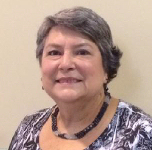
Cindy Noe
Ms Noe is a former Indiana State Representative serving District 87 for more than 10 years. She has served on and chaired several important committees in the state legislature. She is also very active in community affairs including the Boy Scouts of America and the Character Council of Indiana.
The issue for discussion today is important enough to keep knowledgeable individuals awake at night.
New technologies and strategies can inflict a decisive defeat resulting in the overthrow of one civilization and replacement by another. Throughout history there has been a long string of such revolutions with the replacement of one civilization by another. The Roman Empire with its advancement in military hardware overthrew previous less advanced civilizations as well as Hellenism. The Blitzkrieg of World War II with its revolutionary military hardware and tactics was on the verge of overwhelming the rest of the world. Historically new technologies and tactics result in limiting the lifespan of empires to about 200 years.
A recent Russian military textbook discusses the coming of ‘no contact wars’. This refers to activities against electronic grids, cyberspace and other civilian critical infrastructures. These could result in a defeat of a nation or civilization in a matter of hours. China, North Korea and Iran are also our potential adversaries in this regard. There is indirect evidence suggesting that these nations have already been practicing such activities. It is a unique time in history when a least successful society on earth, such as North Korea, can destroy the most successful society. It is the ultimate in asymmetric warfare.
An electromagnetic pulse(EMP) is a strong electronic pulse most commonly caused by a nuclear explosion. There are three components to the electromagnetic pulse: E1 is a free field energy pulse that damages, disrupts and destroys electronics and electronic systems in a fraction of a second over a very large area, E2 is much less devastating and has effects similar to lightning, E3 is a longer duration pulse lasting upwards of one minute disrupting long energy transmission lines and bulk distribution systems including transformers. The combination of the 3 can cause irreversible damage to electronic systems and destroy a nation's grid.
The two main sources of an electromagnetic pulse are man-made or a naturally occurring disaster as in a severe geomagnetic disturbance such as occurs about every 150 years in Earth's history. The electrical grid referred to is made up of varying sizes of transformers, capacitors, high-voltages lines, and control devices, etc. that crisscross our country. Our bulk power distribution system is 97% owned by the private sector.
Several federal commissions and administrations have been set up to protect critical infrastructure but as yet there is nothing established to effectively protect our grid. Several congressmen and senators are well aware of the situation and are working on such protections but as yet none have been completely funded. A presidential Executive Order might be the most effective way to accomplish this.
Notes by Jerry Kurlander
Website Addendum: For those who may interested in more information, a very comprenhensive and impartial analysis of the security of the US Electrical Grid was published by the non-partisan Center for Study of the Presidency and Congress in 2014. See http://www.thepresidency.org/sites/default/files/Final%20Grid%20Report_0.pdf. This document includes an excellent description of the US Grid Systems (p.17); FERC and NERC (p.18-19); the US/Israeli Stuxnet operation against Iran's nuclear facilities; various physical breakdowns of the US grid including the NorthEast Blackout in 2003 (p.25-27), the attack on an electrical Sub-station in Metcalf, CA (p.27-28), and others. It describes the Carrington Event in 1859 caused by an enormous group of sunspots which would have dire consequences if it happened again with the current systems (p.36). Considerable information is provided on potential threats from Russia, China, Iran, and North Korea as well as various non-state actors. This analysis reviews the physical security of our current grid, generation facilities, sub-stations and transmission lines. The specific danger from EMP is summarized together with the work of the federal EMP Commission (p.64-67). There is considerable information on various executive actions by the Obama administration and on various bills introduced but not enacted by Congress. It summarizes the unique role of states and devotes many pages on possible solutions to the problem including Smart Grids and microgrids
Vol 93 No 32 - August 22, 2016
William Henry Harrison, Governor, General, and United States President
Presented By: William H. Dick, Past President, Scientech Club
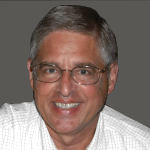
Bill Dick
A case could be made for the Harrison family being the first among American political families, which would also include the Adams and Bush families. Benjamin V was a member of the Virginia House, a delegate to the Continental Congress, a signer of the Declaration of Independence and a Governor of Virginia. William Henry was Governor of the Northwest and then the Indiana Territory. He was a General at the Battle of Tippecanoe and the Battle of the Thames, a U.S. Senator from Ohio and President of the U.S. in 1840. His son, John Scott Harrison was a member of the U.S. House from Ohio. Benjamin VII was a General in the Civil War, a U.S. Senator from Indiana and President of the U.S. in 1888.
William Henry Harrison (WHH) was the: last president born as a British subject, first president to campaign for office, first candidate to release a health report, and was the oldest president to take office until Ronald Reagan. Furthermore, he gave the longest inaugural address, had the shortest presidential term and was the first president to die in office.
WHH was born at Berkeley Plantation, which had been in the Harrison family since 1630. He attended Hampden-Sidney College in Virginia and then studied to be a physician. After his father died, he entered the U.S. Army. He was sent to Ft. Washington (Cincinnati) and was an aide to Gen. Anthony Wayne. He was with Wayne at the Battle of Fallen Timbers near Toledo, Ohio in 1794. The following year he was present at the Treaty of Greenville (Ohio), which effectively ended the conflict with the Indians in Ohio and Indiana.
In 1796, now out of the military, WHH married Anna Symmes, and moved to a 160-acre farm in North Bend, Ohio (now part of Cincinnati). In 1798 he was named the first secretary of the Northwest Territory and a year later was a non-voting delegate to Congress. He proposed the Harrison Land Act, which was adopted; it allowed public lands to be bought at a cheaper price. President John Adams named WHH to be the Governor of the NW Territory in 1800. In 1801, he and Anna moved to Vincennes, the capitol of the Indiana Territory.
The Northwest Ordinance of 1787 provided land for what became OH, IN, IL, MI, WI and MN. It did not allow slavery. It also provided that a University be built. OH became a State in 1803 and in 1804 Ohio University became the first college in the Territory. In Vincennes, WHH built Grouseland (completed in 1804), a large brick home near the Wabash River. Vincennes had been a French capital since 1732, but it was captured from the British (who took over after the French & Indian war) by Col. George Rogers Clark. It had a Catholic Church, a newspaper and the University of Vincennes. Later it had a bank, post office, a library and a medical society.
In 1803, President Thomas Jefferson named WHH to be the Indian Commissioner, and in time 60,000,000 acres were purchased for the United States. WHH won the Battle of Tippecanoe in 1811 and the Battle of Thames (Canada) in 1813. After America won the War of 1812, Harrison retired to OH. He was elected to the Ohio Senate and to the U.S. Senate from Ohio. In 1828-1829 he served as Minister to Columbia. After losing the presidential election of 1836, he won the election of 1840 as a Whig candidate.
WHH gave 23 speeches in Ohio during his presidential campaign, making him the first candidate to actually campaign for office. He received and answered many letters. Women joined the campaign, also. The election of 1840 had an 80% voter turnout. WHH beat Pres. Martin Van Buren by 234 electoral votes to 60. WHH promised to reform executive appointments and make them according to talent, not just to membership in a political party. He was inaugurated on 4 Mar 1841 and died on 4 Apr 1841, making him the first president to die in office.
Notes by Bill Dick
Vol 93 No 33 - August 29, 2016
TOUR – Behind-the-scenes tour at Indiana Historical Society
Presented By: Suzanne Hahn, VP Archives and Library, Indiana Historical Society
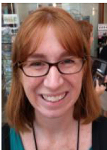
Suzanne Hahn
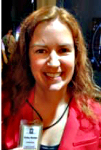
Kathy Mulder
We met at the Indiana Historical Society (Eugene & Marilyn Glick History Center, 450 W Ohio St.). Our tour guide was Suzanne Hahn, VP, Archives & Library.
The Indiana Historical Society was founded in 1830 making it one of the oldest State historical societies. It is also a private organization and one of the oldest in the State of Indiana. Their goal is to be the “storyteller” of Indiana’s history via programs and workshops. A recent example was the “Bi-Centennial Train” exhibit at the Indiana State Fair. The Scientech Club archives are now part of the Historical Society collection.
The tour started on the main floor with Destination Indiana which opened in 2010 in the R. B. Annis Gallery. A panoramic 8’ by 25” video screen dominates the room where the “storytelling” theme of Indiana’s history is told in the form of over 300 Journeys. These cover a wide range of themes including individuals, business, science & technology, manufacturing, agriculture, places, events, sports, etc. Any can be shown on the main screen as part of a tour. In addition, there are 8 kiosks each with a large flat screen display. On these touch screen displays, visitors can take their own “journey” by accessing any of the 300 Stories (Journeys). The upgrade to touch screens was made possible by a donation from the Scientech Foundation.
The tour then moved to the Conservation Lab which is not open to the public. The Lab’s objective is to conserve exhibits, but not to restore them to their original form. Most of the items are paper based, e.g. > documents, photographs, manuscripts, maps, letters, books, etc. Many are damaged with stains, adhesives, contamination from framing/matting materials or just dirt and grime. The lab has a variety of techniques to dissolve or absorb the contaminants. One such technique uses a gum to absorb the contaminant without getting the document/photograph wet. Another technique is to use a suction table with chemical agents to remove residue without touching the item.
Photo albums can be tricky as the photos are often brittle, but contaminated with tape adhesives binding the photo to a matte. In removing and cleaning the photos, care must be taken not to lose inscriptions on the matte beneath the photographs. Often photographs are too fragile to allow use of the originals so they are digitized for online access. (About 60K items out of 2 million in the collection are digitized at this point.)
Sometimes items are not accepted due to mold. This can present a risk to the Lab staff themselves. All the Lab staff have degrees in Art Conservation. The Lab does not do conservation for private parties, but will consult for a fee for Historical Society members.
The third phase of the tour was to the “Vault” where all the originals are stored (including Scientech’s). That portion of the building is reinforced structurally. The temperature is maintained at 65-70 F and the humidity at 55%. An anecdote from the vault, > they have a 18” statue of a Ku Klux Klan man in full white robe, but with a missing left arm. In fact, the arm is detachable. The story goes that at Klan meetings, if the arm was detached, there were spies present, so do not speak freely.
The tour concluded in the William H. Smith Memorial Library where parts of the collections of R.B. Annis, Elwood Haynes, and D. J. Angus where on display for our perusal. Also on display were some fascinating historical maps. The Library is open to the public as part of admission. Hours are 10-5 Tuesday - Saturday.
As an aside, the building is spacious and beautiful and well located along the canal and within walking distance of many downtown attractions.
Thanks to Jim Bettner for arranging the tour and to Bonnie Carter for hosting. Suzanne Hahn Kathy Mulder
Notes by John Peer
Vol 93 No 34 - September 12, 2016
Owning a professional hockey team in a basketball, football, auto racing town.
Presented By: Jerry Williams, Scientech Club Member
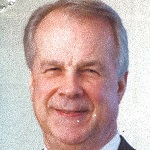
Jerry Williams
Today’s presentation was delivered by Mr. Jerry Williams, owner of central Indiana’s professional hockey team, the Indy Fuel. Indy Fuel are a member of the ECHL league, an AA league. The NHL is the premier league and contains 30 teams. The American Hockey League is junior to the NHL and also has 30 teams. The league the Fuel is in, the ECHL, is equivalent to the AA league in baseball and has 26 teams that have an affiliation agreement.
Jerry is a native Hoosier, a graduate of IU and IU school of law. He is a resident of Indianapolis, a banker, a lawyer, a photographic artist and a member of the Himalayan helicopter club along with Club member Dave Culp. Jerry is a long standing baseball fan but only within the last decade or so has become a hockey enthusiast.
Jim Hallet, a Canadian, bought the former Indianapolis team, the Ice, in 1999. It was a single A team and won the championship that year. It left the Indianapolis athletic scene in 2004.
In 2009 Jerry retired. He was approached by Jim Hallet to help him bring hockey back to Indy. Jerry didn’t know much about the sport but agreed to help. A company that builds hockey rinks, the BBB, and the company called SCI that specializes in venue affairs, was approached to build a facility near 131st and SR 37 but that fell through. The impending renovation of the Coliseum was offered to them as a place to house their team if they agreed to put a team on the ice in a year.
After many hurdles, deals and difficulties were overcome they were successful. They had to meet the owners of ECHL teams, get their approval, find players and coaches, etc. in a very short time. The affiliation agreement said that from 5 to 8 players would be provided. The rest had to be found. The deal with the State Fair board said they would pay $900,000 a year to use the facility in the initial years of the 25-year agreement.
He is very pleased with the treatment the team and fans get at the newly remodeled Indiana Farmers Coliseum. The remodel was a good job. He wants to provide the fans a good experience.
The person who is their mascot “Nitro” is also at times “Rowdy” for the Indians and “Boomer” for the Pacers. He was the Arkansas Razorback’s mascot for 4 years as well.
There are 20 players on a team, many are right out of college.
Some Sundays after the game there’s open skating available to the fans.
Jerry again said that the State Fair employees give excellent customer service.
The Fuel has given about $500,000 to the community for various service projects over the last 2 years.
(Ed. note: see https://www.indyfuelhockey.com/ )
Notes by Jim Dashiell
Vol 93 No 35 - September 19, 2016
How Lilly Endowment is working to Improve Education in Indiana
Presented By: Sara B. Cobb, V.P. for Education, Lilly Endowment, Inc.
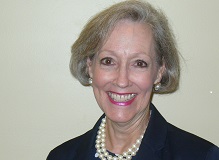
Sara B. Cobb
She addressed the group about How Lilly Endowment is working to Improve Education in Indiana from pre-K through higher education.
Lilly Endowment was founded in 1937 by three members of the Lilly family – J.K. Lilly Sr. and sons J.K. Jr. and Eli – through gifts of stock in their pharmaceutical business, Eli Lilly & Co. The Endowment continues the founders’ wishes and supports in three major areas: Community development, Education and Religion. The founders’ foremost priority was to help the people of their city and state build better lives.
The four Principal Aims of Lilly Endowment’s education grant making are:
1- Enhance and increase the educational attainment of Indiana residents;
2- Enhance and increase opportunities for meaningful employment for Indiana residents;
3- Help build the state’s intellectual capital, and
4- Promote higher education access and success for certain underserved constituencies in Indiana and beyond.
These four aims help to establish a continuum with subordinate activities that also have four focal points.
1- Early Childhood Development, pre-K, critically requires highly skilled teachers and counselors to start and set the educational course properly for all children. This is not a baby-sitting type of operation!
2- Elementary, Middle, and High Schools extend the breadth of education and help to establish further love for learning. Key outcomes and best practices must be set and evaluated. Specific subject matters must be addressed.
3- Access to and success in Higher Education requires student preparedness and readiness for all levels of education needed; access to information and achievement of key outcomes are necessary.
4- Ready to work means that emerging and continuing job opportunities forecasts are accurate and made known in sufficient time to educational systems and the oncoming students transitioning into that new era of educational requirements. Work ready students that are graduating must have the knowledge and skill sets to meet rapidly changing opportunities in the workplaces.
Currently, the “half-life of knowledge” is short compared with the time spent in educational institutions. Thus, continuing education is very necessary. The program has increased the desire of students who are educated in Indiana to stay in Indiana. There are many places around our state that have exciting opportunities for meaningful jobs for the work ready students that graduate. Proper strategy, planning, education, and execution are keys for success!
Some special support organizations and activities have been implemented to enhance the various Educational Programs.
1- Early Learning Indiana exists to provide leadership, advocacy, and early childhood education services to continually improve the early learning landscape in Indiana.
2- STEM – Science, Technology, Engineering, and Mathematics has five vital programs working with educators and students in the state.
3- Several educational and workplace challenges have been identified and steps to remediate these challenges are being funded. One example of emerging needs is: Studies project 62 percent of jobs in five years (2021) will require post-secondary credentials. Currently only 42 percent of workers in Indiana have a post-secondary credential. Indiana has a goal to reach 60 percent by 2025.
4- The Foundation is in the third of three rounds that began in 2003, with grants totaling $120 million, in connecting Indiana college and university students and graduates with Indiana; with a variety of necessary strategies.
5- The Lilly Endowment Community Scholarship Program has provided funding for about 4000 students so far with the following guidelines: It is available in every Indiana county. At least one scholar, based on population, with up to nine in Marion County. Scholarships are provided for any Indiana college or university, and include full tuition, required fees and books. These are offered through Indiana’s community foundations, and administered by Independent Colleges of Indiana
6- Ready for Work - provides support in the areas of understanding of the breadth and depth of the education needed.
7- TechPoint helps to provide students with experience and internships in central Indiana.
8- Conexus Indiana provides an Initiative of the Central Indiana Corporate Partnership to address the skills gap. It has an extensive interns program. We are very fortunate to have these types of activities and financial aid provided for many programs as is funded by the Lilly Endowment, Inc.
Notes by Dick Carter
Vol 93 No 36 - September 26, 2016
Bud Adams's Gift to the Eiteljorg Museum
Presented By: James Nottage, Curator
Speaker: James Nottage, Vice President, Chief Curatorial Officer and Gund Curator of Western Art at the Eiteljorg Museum. Introduced by: Ed Cockerill
He discussed the Bud and Nancy Adams gift to the museum, and the exhibition in November 2016 of 60 pieces of the collection.
Bud Adams and his wife were always greatly interested in Native American art and wished that their collection be used for educational purposes.
Over several years, the Eiteljorg and the Adams family developed a good relationship and when he passed away in 2013, his collection was donated to the museum.
Bud Adams graduated from Culver Military Academy and the University of Kansas. He founded the Resources and Energy Co. Besides Western Art, he helped found the
American Football League and owned the Houston Oilers and later, the Tennessee Titans. By way of his mother, he was part Cherokee. He was familiar with that tribe,
but he also knew a great deal about other tribes such as the Delaware and the Sioux. As a result of this, he liked Indian art and always wanted to help young Indian artists.
Mr. Nottage presented a number of photographs of paintings from the collection by Remington, Wyeth, Kerner, and Sharp.
There were also pictures of artifacts from numerous tribes including Indian dresses, moccasins, tobacco pouches, blanket straps, and pipes.
Also discussed were some of the challenges of repairing paintings after they had aged as well as the complexity of repairing damaged artifacts.
The use of a portable X-ray florescence machine has helped in testing for the presence of heavy metals to help insure staff safety during the restoration process.
Photographs of paintings after they had been restored were impressive.
Notes by Russell Judd